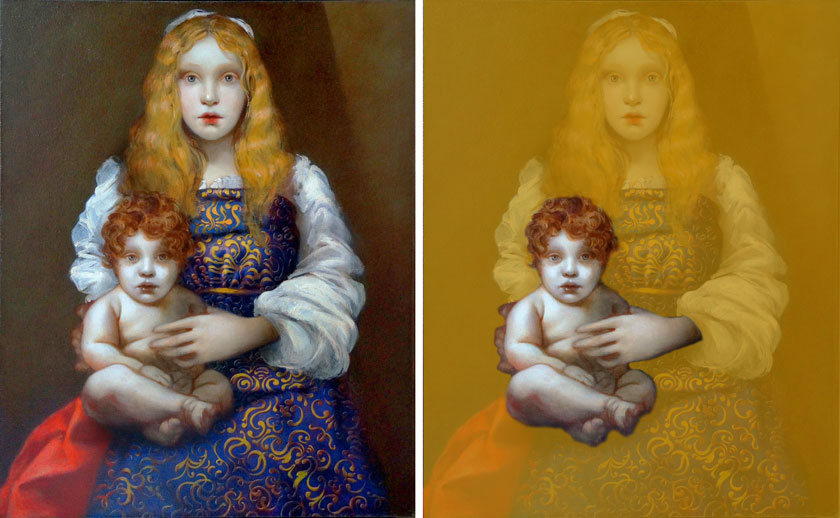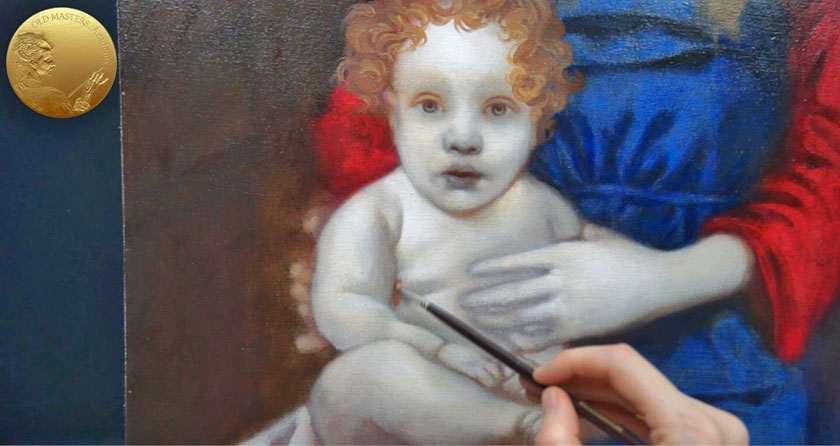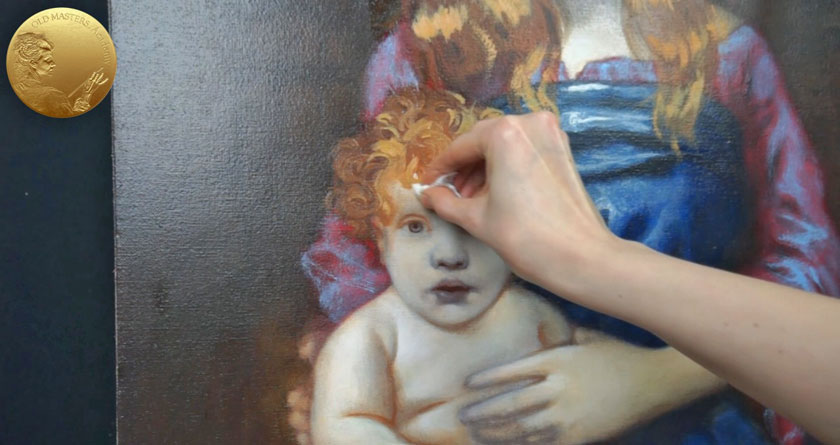Art Lesson 42, Part 3
Discover How to Paint a Child in Oil
Learn how to paint like the Old Masters!
Old Masters Academy Online Course
Self-study, self-paced online video courseLifetime membershipOne-time payment: $487Enroll Now!Personal Tutoring online + Online Course
Unlimited tutoring by the Academy teachersLifetime membershipOne-time payment: $997Enroll Now!« Back to the Art Lessons List
How to Paint a Child in Oil
Session One
We are ready to proceed with layers in Color. At this point, the Grisaille Underpainting should be completely dry.

We mix Transparent Gold Ochre and Burnt Sienna with Stand Linseed Oil. Apply the Glaze over the whole surface, including lighted and shaded areas. Use a rigid Hog Brush for this step.
Do the same for the hand. The Glazing layer should be applied thinly.
Session Two
This is how the first layer of Glaze over an Underpainting looks like. A thin coat of Glaze allows the White Grisaille to show through. We mix the same paints: Transparent Gold Ochre and Burnt Sienna with Stand Linseed Oil. This is our Second Glazing layer, which is over a previous layer, which is completely dry.
The process of glazing over large areas is simple: first we apply diluted paint, then we spread it with a larger, clean brush.

While the Glaze is viscous, we apply a layer of Velatura (Opaque Glaze). We use Stand Linseed Oil as a Medium and mix Titanium White and a bit of Transparent Gold Ochre. Velatura makes lights more even, but darkest areas cooler. Such a semi-opaque, milky effect is possible to create only by the means of Velaturas. While the yellowish Glaze is still wet, we do the same with the hand. That is it for this session.
Session Three
We apply another layer of Velatura over a completely dry surface. The medium and the paint is the same as before. We gradually build up the texture of the skin, layer after layer. In the lightened areas, apply a thicker layer of paint. Also, build up layers of milky Velaturas over the hand.
Work on the details. We are now using Venetian Red and Burnt Sienna, mixed without a Medium. Outline the contour with unthinned paint, then gently spread it with a clean, soft brush. The paint can slightly intermix with the freshly applied Velatura. At this step, we can proceed to painting the hairs.
First, we block-in the mass of hair with curved strokes. We use the same limited number of Oil Paints: Venetian Red and Burnt Sienna. No Medium is added. Add Yellow Ochre and Titanium White to the mixture for the highlighted curls.
Unwanted paint can be easily removed with a piece of soft tissue. The lower layer will not be affected, as it is well-dried.

To add colorful vividness to the pale skin, we will paint contours and skin folds. For this purpose, we will mix Venetian Red and Burnt Sienna, adding Stand Linseed Oil. At this point, the hand looks too flat, so we will cover it with a thin layer of Glaze. This time, we use Yellow Ochre and Charcoal Grey with Stand Linseed Oil. The more shaded an area is on the hand, the thicker the Glaze layer needs to be applied.
Session Four
We continue over a completely dry surface. For dark areas, mix Venetian Red and Burnt Sienna. For highlighted areas, add Yellow Ochre and Titanium White to the same mix. As a Medium, we will use Stand Linseed Oil. (Which is optional)
We prepare the Venetian Red, Yellow Ochre and Burnt Sienna mixed with Stand Linseed Oil. With this mix, we are glazing warm semi-transparent shades. Smooth out the Glaze with a soft brush.
That is it – we are halfway through. It took us four painting sessions.




